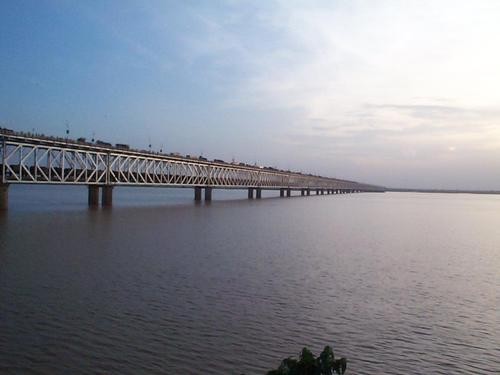Godavari River known as the Dakshin Ganga is the second largest river in the country touching upon basically three states and helping in being the lifeline for the people in these three states. With a length of 1465 Kilometers, Godavari is also the longest river in South India. The river has been revered in Hindu scriptures since many millennia and continues to harbor and nourish rich cultural heritages. However, in the past few decades, the river has been abused with relentless construction of barrages and dams.
Religion World will look at the rivers that call for immediate attention, because they have been polluted beyond repair. But the effort is to look at the river, its history, its use and how it was been brought to the state it is now. Our effort to write about these rivers is to enlighten the readers that they need attention and they can once again turn into lifeline for human race in their part. Today we bring, river flowing through three states of Maharstra, Telangana and Andhra Pradesh, Godavari River.
Godavari River:
Apart from Ganga and Yamuna, Godavari also holds the special religious importance in India. Godavari is one of the sacred river in India. According to the puranas River Ganga should only be visited after the visit to the Godavari. There are several pilgrimage places on the banks of the river. Some of them include Trimbakeshwar – the ancient temple of Lord Shiva, Nanded Takht Sri Hazur Sahib, one of the sacred place among the Sikhs, Bhadrachalam – temple of Lord Rama and many more.
Godavari is sometimes also referred to as the ‘Ganga of the South’. After every twelve years, a major bathing festival called as Pushkaram is held on the banks of the Godavari river. Some of the prominent personalities who took bath in its holy water include Baladeva and Chaitanya Mahaprabhu.
Must Read #KnowYourRivers : Musi
Must Read News Updates – South
Origin & Flow
Godavari river originates near Trimbak in Nashik District of Maharashtra state and flows east across the Deccan Plateau into the Bay of Bengal near Narasapuram in West Godavari district of Andhra Pradesh. The Godavari is sacred river and there are several places of pilgrimage on its banks. Trimbakeshwar and Nasik are major pilgrimage sites where one of the four Sinhastha Kumbh Mela takes place. Every twelve years, Pushkaram, a major bathing festival, is held on the banks of the Godavari. The last Pushkaram festival was held in 2015.
The river originates from Trimbak and then flows in the east across the Deccan Plateau traversing through the Trimbakeshwar, Nashik, Kopargaon, Paithan, Nanded, Rajahmundry, Adilabad and Bhadrachalam.
Just after Rajahmundry, the river splits into two streams that widen into a large river delta, which provides an extensive navigable irrigation. In Nizamabad district of Andhra Pradesh, there is a multipurpose project on the Godavari, which is called the Sriramsagar Project. Godavari empties into the Bay of Bengal near Narasapuram in West Godavari district of Andhra Pradesh.
Bridges and Barrages on Godavari
A barrage was built on the river at Dowleswaram by Sir Arthur Cotton in 1852. As it was damaged in 1987 floods, it was rebuilt as a barrage and roadway during 1987 and named after him. The roadway connects Dowleswaram in East Godavari and Vijjeswaram in West Godavari.
There is also a big dam built just after the source of the river at Trimbakeshwar. The dam is in the town of Gangapur, which literally means a town on a river. The dam provides drinking water to the residents of Nashik and also supplies water to the thermal power station situated downstream at Eklahara, which provides power to the town.
There is another multipurpose project on the Godavari River named Sriram Sagar Project on the borders of Adilabad and Nizamabad District. It is in the town of Pochampad, 60 km away from Nizamabad. It irrigates 4 districts of Northern Telangana Region of Andhra Pradesh and supplies power.
The Jayakwadi dam near Paithan is one of the largest earthen dam in India. This dam was built to address the problem of drought in Marathwada region and problem of flood along the bank of river. Two ‘left’ and ‘right’ canals provide the irrigation to fertile land up to Nanded district. This dam has major contribution in industrial development of Aurangabad Maharashtra.
Havelock bridge is on Godavari River. It was constructed under the supervision of F.T. Granville Walton who had constructed the Dufferin Bridge over the Ganges, and Granville Mills, British engineers. Spanning over 3 km in length, it linked the East Godavari and West Godavari districts. The brige has been a vital link enabling trains to run between Chennai and Howrah. Trains continued to ply over the bridge for a century until 1997, when train services over the bridge were suspended after the construction of 2 additional bridges.
Tributaries
The principal tributaries of the River Godavari are Penganga, Pranahita, Sabari, Indravati, Manjeera and Manair.
Indravati River: Indravati River rises in the Eastern Ghats in Kalahandi Orissa, and flows west to join the Godavari, forming the boundary between Maharashtra and Chhattisgarh states at places. The river flows for a length of 535 km with a drainage area of 41,665 sq.km.The Indravati is sometimes known as the “lifeline” of the Bastar District, one of the most green districts in India.
Pranahita River: Pranhita River flows on the border of Gadchiroli district in Maharashtra and Adilabad district in Andhra Pradesh. It forms with the confluence of two rivers called Wardha and Wainganga.The Painganga River joins Vainganga near Aheri. The river then flows up to Sironcha before it empties into the Godavari River,near Sironcha in Maharashtra. The River course is mainly through the dense forests which are rich in Sagwan (timber).
Legend
The river is sacred to Hindus and has several places on its banks, that have been places of pilgrimage for thousands of years. Amongst the huge numbers of people who have bathed in her waters as a rite of cleansing are said to have been the deity Baladeva 5000 years ago and the saint Chaitanya Mahaprabhu 500 years ago. Every twelve years, Pushkaram fair is held on the banks of the river.
A legend has it that the sage Gautama lived in the Brahmagiri Hills at Tryambakeshwar with his wife Ahalya. The couple lived the rest of their lives in the then village called Govuru, known as Kovvur (“cow”) since the British rule. Ahalya lived in a nearby place called Thagami (now Thogummi). The sage, as a reason for the practice of annadanam (“giving away food” to the needy), started cultivating rice crops and other crops. Once, the god Ganesha, on the wish of the munis, sent a miraculous cow maaya-dhenu, which resembled a normal cow. It entered the sage’s abode and started spoiling the rice while he was meditating. Since cattle is sacred to Hindus and shall always be treated with respect, he put the dharbha grass on the cow. But, to his surprise, it fell dead. Seeing what happened before their eyes, the munis and their wives cried out, “We thought that Gautama-maharishi is a righteous man, but he committed bovicide (killing of a cow or cattle)!”. The sage wished to atone for this grievous sin. Therefore he went to Nashik and observed tapas to Lord Tryambakeshwara (a manifestation of the god Shiva), on the advice of the munis, praying for atonement and asking Him to make the Ganges flow over the cow. Shiva was pleased with the sage and diverted the Ganges which washed away the cow and gave rise to the Godavari river in Nashik. The water stream flowed past Kovvur and ultimately merged with the Bay of Bengal.
Temples on Godavari banks
- Gnana Saraswati temple in Basara
- Sita Rama temple in Bhadrachalam
- Narasimha temple in Dharmapuri
- Kaleswara Mukhteswara swamy Temple in Kaleshwaram
- One of the twelve Jyotirlingas and ancient temple of Lord Shiva in Trimbakeshwar
- Takht Sri Hazur Sahib, one of the five most sacred places in Sikhism in Nanded
- Laxmi Narasimha Swamy temple in Antarvedi, East Godavari
Ecological issues

Godavari river is under the serious threat as a result of the growing Urbanization and industrialization. The river has been dying at an alarming rate due to the pollution created by the factories. The main reason behind the pollution of Godavari river is the tiny Nakavaggu rivulet, which joins the Manjira, tributary of the Godavari. Nakavaggu rivulet supports no life at all. Rivulet is surrounded by the highly productive agricultural land, which is polluted by the large number of industries lying near the twin cities of Secunderabad and Hyderabad. However the 72 industries in the Patancheru Industrial area dumping the chemicals and waste into the water are most responsible for the pollution of the river. It has also given rise to some of the major diseases such as lung cancer, leukemia, and liver cancer.
Must Read #KnowYourRiver : Krishna River









